Building regulations - proposed changes to energy standards, etc: consultation analysis
An analysis of the responses to the 2021 public consultation on a review of building standards relating to energy standards and associated topics, including ventilation, overheating and electric vehicle charging infrastructure.
6 Part 5 – Overheating risk in new dwellings and other residential buildings
In the consultation document, the BSD proposed that any new provision to assess and mitigate against the risk of summertime overheating should apply to all new dwellings, subject to the application of a set of trigger criterion that determine the need to consider the design and specification of the dwelling further to mitigate such risk.
The BSD also proposed that the same assessment be applied to non-domestic residential buildings where the built form and occupancy is similar to dwellings (e.g., self-contained student flats accessed off a common area).
6.1 Scope of application
6.1.1 Question 41
Do you agree with the proposed introduction of a requirement to assess and mitigate summertime overheating risk in new homes and new non-domestic residential buildings offering similar accommodation?
One hundred responses to this question were received, and 84 responses to the accompanying open question. Five respondents provided an open response but did not answer the preceding open ‘yes/no’ question.
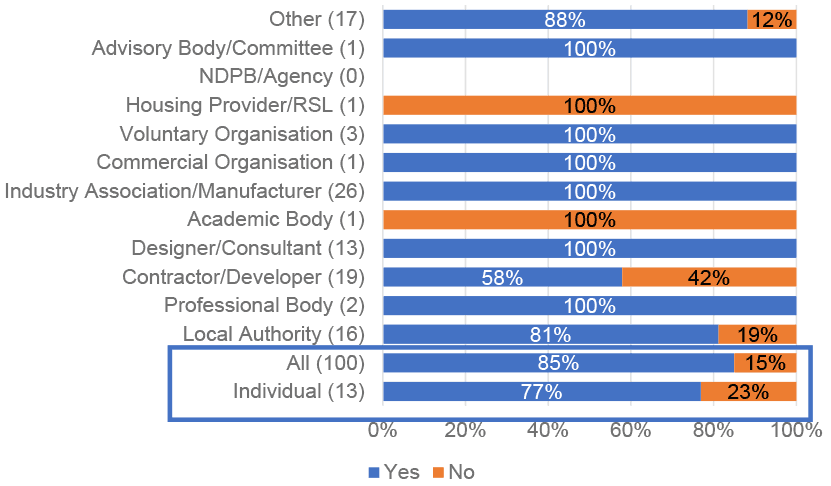
Base: 100 respondents (76 no response) NB Individual respondents are listed separately at the bottom for information - as they are included in organisation responses (per Section 2.3
6.1.2 Support for the proposal
Overall, 85% of respondents to the closed question are supportive of the proposal (Figure 46).
Some respondents agreeing with the proposal chose to give reasons for their answer, the main reason given was climate change, which was specifically mentioned by sixteen respondents.
Many respondents also detailed risks to health and welfare associated with overheating, including physical and mental health problems; morbidity and mortality rates in the context of an ageing population; as well as implications for productivity and concentration.
Other reasons for supporting the proposal include increasing fabric u-values and airtightness, increased likelihood of the use of lightweight materials with low thermal mass, and avoidance of costly retrofitting. A few respondents mentioned windows as a contributor to overheating, one suggested that assessing new homes for summer overheating risks, might force architects and house builders to have second thoughts on what is a desirable amount of glazing.
Among those agreeing with the proposal a few respondents expressed concern regarding the reliance on mechanical means e.g., air-conditioning to overcome overheating. Two respondents went on to state that natural solutions are cheaper to build in at the construction stage, and that the life-cycle costs for a new build are approximately 20% on construction and 80% for the rest of the building's life. A Trade Association also stressed the importance of passive measures prior to the installation of energy intensive cooling systems, in line with the European Energy Performance Building Directive and the Greater London Authorities Cooling Hierarchy. The same respondent and one other respondent highlighted the importance of Solar Shading.
The following comments were each noted by a few respondents:
- The overheating risk should be addressed by a new Building Standard. A Profit for Purpose organisation urged caution, stating that this is only the right choice if the requirements are robust and effectively enforced.
- The proposal should only apply to any development without air conditioning.
- Concerns about the verification process and the additional burden on the designer and verifier.
- PHPP has a built-in methodology for assessing overheating risk based on the calculation of shading for as designed windows and suggested that adoption of the PHPP as a compliance tool would streamline the approval process for this section of the building standards.
6.1.3 Not in support of the proposal
The predominant view among several respondents unsupportive of the proposal was that overheating is not an issue in Scotland.
6.1.4 If you consider that proposals should be extended to non-domestic buildings which provide other forms of residential accommodation (which are not 'self-contained residential units'), we welcome your views on such provisions, including if the same or alternate approach to assessment is recommended?
Of the 34 respondents to this open question. Fourteen chose not to go in to detail, simply re-iterating their support or stating this would be logical or would add consistency to the process.
A few respondents supported extending the proposal to care homes, with a Not-for-profit organisation reasoning that people living in these buildings will be significantly more vulnerable to the impacts of overheating in the buildings in which they live than other groups.
A minority supported extension of the proposals to all buildings, with one respondent recommended that the same approach be considered for non-domestic residential, particularly where occupants have limited opportunity to utilise other spaces in hot weather.
A number of respondents raised provisos in relation to extending the proposal:
- Noise levels need to be amended to reflect relevant guidance.
- Flexibility should be built into the requirements to ensure that undue constraints are not placed on the construction of new dwellings.
- Consideration should be given to commissioning testing of noise from mechanical systems.
- The management of noise, ventilation and overheating still has a firm place at the planning stage.
Many respondents suggested the same methodology is used for all buildings. Few respondents commented on alternative approaches to assessment.
6.2 Application of criteria for assessment
6.2.1 Question 42
Do you agree with the proposal that an initial assessment of dwelling characteristics should be undertaken to help inform design choices and the delivery of new homes which provide better thermal comfort in the summer months?
Ninety-two responses to this question were received, and 74 responses to the accompanying closed question. Nine respondents provided an open response but did not answer the preceding open ‘yes/no’ question.
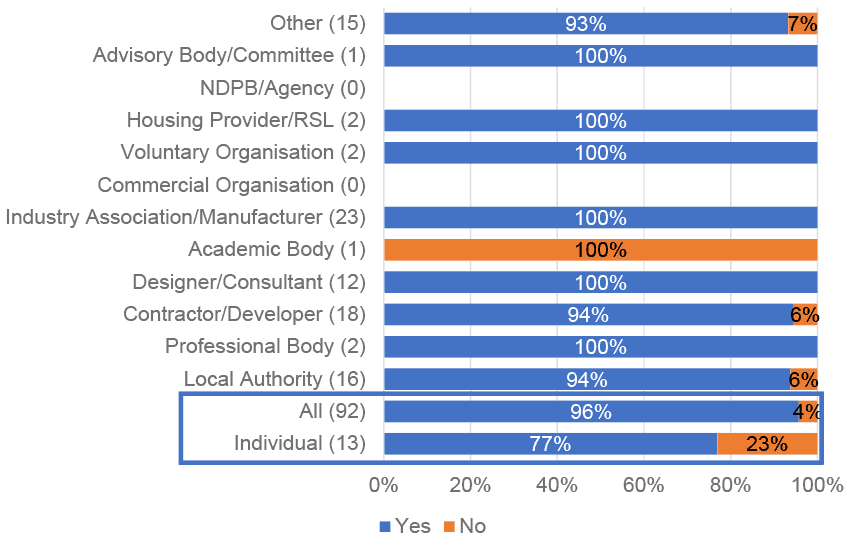
Base: 92 respondents (84 no response) NB Individual respondents are listed separately at the bottom for information - as they are included in organisation responses (per Section 2.3)
6.2.2 Analysis
Overall, 96% of respondents answering the closed question agreed with the proposal (Figure 47).
Respondents agreeing with the proposal gave reasons for their agreement, caveated their response, or made suggestions to improve the process.
Several respondents stated their reason for supporting the proposal was to help ensure any risk of overheating is tackled at the outset to avoid having to retrofit mitigation measures. Similarly, respondents were of the opinion that early taking of decisions on the design of the building such as size and position of windows would lead to cost savings.
Several respondents supported passive mitigation measures e.g., shading rather than mechanical ventilation and air conditioning.
Some respondents praised the ‘simple’ approach. Other respondents (while still supporting the proposal) thought it overly simplistic.
Respondents commenting on glazing highlighted the importance of balancing limiting overheating against the benefit of natural light, glare, and adequate views.
A few respondents called for clarity of the guidance and to what it applies. They also recommended that illustrations and example diagrams should be provided.
A further few respondents suggested that feedback on measures implemented should be sought. For example:
- On-going assessment of the effectiveness of any chosen mitigation strategies in order to build library of outcomes from which others can learn.
- The proposal to use triggers might not cover all properties and in-use performance should be considered to assess whether the mitigation strategies have worked, and that the metrics are suitable.
- Consideration of the views of respondents on other sources of good practice guidance which have been implemented by developers and the outcome evidenced through feedback from residents.
A few respondents recommended that the proposals take into account thermal mass of building materials.
6.2.3 We would also welcome your knowledge and views on other sources of good practice guidance which have been implemented by developers and the outcome (e.g., no reports of significant summertime overheating) evidenced through feedback from residents.
Other sources of good practice guidance recommended by respondents are:
- Overheating in New Homes – Tool and guidance for identifying and mitigating early-stage overheating risk in new homes (2019).
- Understanding overheating – where to start (NF44) NHBC.
- Zero Carbon Hub documentation published in 2016
- Avoiding summer overheating’ Passivhaus Trust.
- MHCLG (now DLUHC) research[3]
- The Good Homes Alliance checklist.
- Design criteria set out in the PHPP tool.
6.3 Should specific dwelling characteristics trigger use of CIBSE TM59
6.3.1 Question 43
Are there circumstances where you consider the specific characteristics of a dwelling should trigger a need for CIBSE TM59 assessment rather than application of a simple elemental approach?
In total, 67 responses to this question were received and 72 responses to the accompanying open question. Fifteen respondents provided an open response but did not answer the preceding open ‘yes/no’ question.
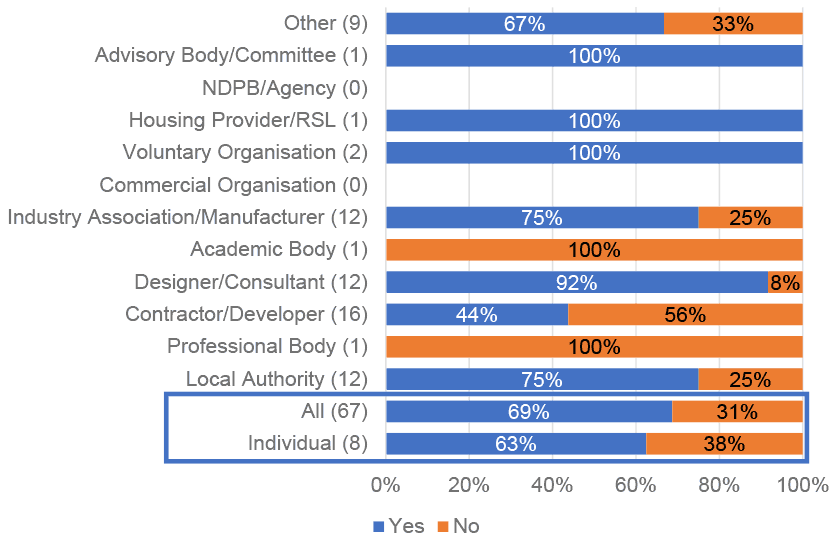
Base: 67 respondents (109 no response) NB Individual respondents are listed separately at the bottom for information - as they are included in organisation responses (per Section 2.3)
6.3.2 Analysis
Overall, 69% of respondents answering the first part of the question agreed with the proposal (Figure 48).
Respondents agreeing with the proposal gave a variety of different criteria they feel should trigger a CIBSE TM59 assessment.
A TM59 assessment should be triggered when a property has large areas of glazing, was a view shared by several respondents. Respondents expanded on this theme with suggestions that the orientation of glazing and the presence of glazing which is difficult to shade should be taken into consideration.
A view shared by several respondents was that reference should be made to mitigation measures when considering triggering a TM59 assessment. An Advisory body/Committee respondent went onto recommend TM59 being triggered where mitigation measures are extensive, which contrasts with an Industry Association/manufacturer respondent who stated a trigger should be lack of mitigating factors.
A few respondents who agreed with the proposal went on to state that a TM59 assessment should be carried out for all developments or all new developments. An Industry association/manufacturer respondent was concerned that the simplified method reduces the process to a tick box exercise and that the actual problem is not addressed.
The following potential triggers were each mentioned by one respondent:
- Buildings with complex forms or internal arrangements.
- Where it is noted during the basic assessment that more than one room, or a percentage of the building could overheat and limited opportunities for external shading due to heritage constraints.
Those disagreeing with the proposal either stated that TM59 should be used for all development; the simple elemental approach is suitable for all developments or that specific characteristics should not define which approach is used.
6.4 Scope of mitigating measures proposed
6.4.1 Question 44
Recognising the level of risk identified in the 'Addressing Overheating Risk in New Dwellings' published research paper, do you agree with the assessment proposals as a suitable means of mitigating summertime overheating in new homes through prescriptive actions?
Seventy-five responses to this question were received and 58 responses to the accompanying open question. Fourteen respondents provided an open response but did not answer the preceding open ‘yes/no’ question. Around half of these were ‘no comment’.
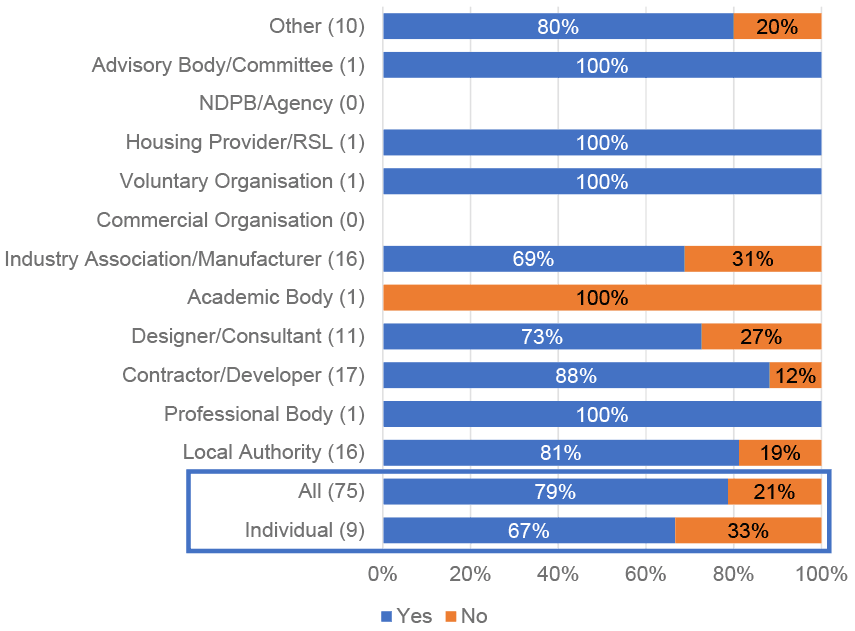
Base: 75 respondents (101 no response) NB Individual respondents are listed separately at the bottom for information - as they are included in organisation responses (per Section 2.3)
6.4.2 Analysis
Overall, 79% of respondents who answered the closed question were in favour of the proposal (Figure 49).
Those in support of the proposal used the open question to voice their general agreement with the prescriptive approach or to go into more technical detail covering specific areas of the assessment proposals.
Several respondents, whilst agreeing with the proposals, thought the methods over simplistic. This contrasted with the views of several other respondents who supported simple prescriptive measures or ‘simple assessment’ at least for less complicated dwellings.
A few respondents (repeating a campaign response) agreed with the mitigation measures proposed but recommended that these should not be too prescriptive and allow variation in design if dynamic modelling demonstrates the risk of overheating is mitigated. Two of these respondents went on to question the exclusion of internal blinds in shading options, claiming that in many instances with the inclusion of appropriate blinds and the education of the homeowner, internal heat gains can be significantly reduced.
A few respondents commented on measures involving specifying the g value of glass; an Industry association/manufacturer thought it important that reducing glazed areas or limiting the g-value of the glass should not be considered a universal solution; and a voluntary organisation asked for care to be taken on site, when different g-values of glass are chosen for different rooms, that this is actually used. The Industry association/manufacturer respondent went on to suggest that the means of reducing the impact of solar overheating should be controllable so as to not have an adverse effect during the majority of the year when solar overheating is not an issue.
A few respondents who disagreed with the proposal recommended that 'baseline' g value be changed from 0.60 to 0.40 to address the problem of overheating and went on to recommend that a 'look up' table is provided, linking glazed area, room floor area and g value.
6.5 Practicality of solutions
6.5.1 Question 45
Do you consider that the approach set out in the proposed standard and guidance will provide adequate assurance that ventilation measures provided to mitigate summer overheating can be used safely and conveniently in practice?
Sixty responses to this question were received and 44 responses to the accompanying open question. Twelve respondents provided an open response but did not answer the preceding open ‘yes/no’ question.
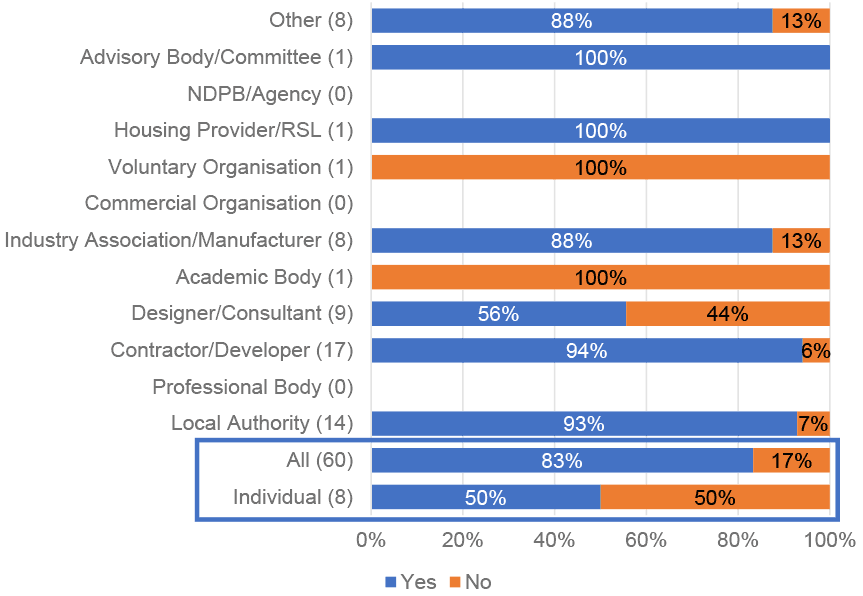
Base: 60 respondents (116 no response) NB Individual respondents are listed separately at the bottom for information - as they are included in organisation responses (per Section 2.3)
6.5.2 Analysis
There was widespread agreement with the proposal – 83% of respondents to the closed question answered ‘yes’ (Figure 50) – though respondents had strong views on factors that might limit the extent to which building occupants use the mitigation measures.
A number of factors that might prevent occupants opening windows were highlighted.
- Excessive noise was suggested as a factor by several respondents, it was acknowledged that the guidance details that this is assessed at Planning stage, however a few respondents suggested there is a risk that this will only pick up on proposals that require formal Noise Impact Assessments, and that other developments could be subject to elevated noise levels outside these conditions.
- Security issues, particularly for ground floor rooms were a concern for several respondents.
- Pollution was highlighted by several respondents as a factor that might limit the extent that occupants are safely or conveniently able to open windows.
- A few respondents repeated a campaign response which mentioned “insect ingress” as something that would prevent occupants opening windows.
A campaign response repeated by three respondents (who chose not to answer the closed question) acknowledged that opportunities to open large areas of glazing may be limited.
6.5.3 Caveats expressed where respondents support the proposal
Several respondents agreeing with the proposal went on to caveat their response.
- A Local Authority commented that consideration should be given air paths within dwellings to ensure that in a new dwelling (where there is greater freedom of design) some degree of cross ventilation should be achievable without all internal doors being open. This response was repeated by two other respondents.
- Six respondents asked that a user guide be provide for occupants; a Trade association had concerns that in practice written information would not be handed over to the occupant.
- Three respondents who chose not to answer the closed question, commented that future effectiveness of the standard and guidance would depend on the extent of climate change.
- Five respondents stated that further research into the impact of any regulatory changes will be required to validate their effectiveness, or that the standard and guidance would need to be in place before their adequacy could be assessed.
6.5.4 Not in support of the proposal
The eight respondents who disagreed with the proposal and answered the open question, largely gave similar comments to those who agreed with the proposal, referring to climate change; factors preventing occupants opening windows; and the need to monitor and assess guidance in practice.
6.6 Further comments on mitigating risk of summer overheating
6.6.1 Question 46
We welcome any other comments you may wish to make on the proposed introduction of provisions to mitigate the risk of summer overheating in new homes and residential buildings.
6.6.2 Analysis
Thirty-three responses to this open question were received. Respondents gave a variety of comments; some took the opportunity to emphasise responses to previous questions, while others provided new information.
A number of themes are discernible from the responses:
- Climate change: a campaign response repeated by three respondents requested that the assessment take into account effects of global warming, use of design assessment tools that work for different climate zones.
- Skills, competence, and training: several respondents highlighted issues on this theme. Specific comments identified a need for an education process for Planning Officers; clarity on the knowledge, skills or experience needed by those undertaking assessments; upskilling for designers; a new competent person scheme should be developed; compliance assessments should be undertaken by qualified and competent professionals.
- Overheating in flats: request for greater guidance
Various considerations were put forward by numerous respondents, however, these had no common themes.
Contact
Email: buildingstandards@gov.scot
There is a problem
Thanks for your feedback